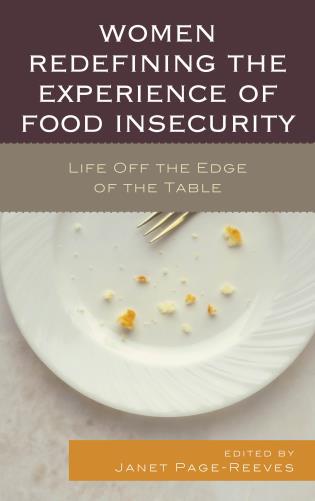In recent years, the issue of food insecurity in the developed world has gone from being met with denial to receiving at least somber recognition in public consciousness. From televised events like the U.S. collegiate football match sponsored by Kraft Foods—‘the Hunger Bowl’—to a multitude of charitable fundraisers, to the cinematic release of the documentary A Place at the Table (2013), it has become hard to ignore the unsettling fact that in lands of plenty many are still scraping together their meals, and all too often are going without. However, this cursory public acknowledgement and largely charitable remediation scheme raises two important questions for cultural anthropologist Janet Page-Reeves: “Are we merely concerned with feeding the hungry? Or are we interested in ending hunger?” (p. 10).What might seem like a subtle distinction here is made stark as Page-Reeves and contributing authors corroborate their central argument in Women Redefining the Experience of Food Insecurity: Life Off the Edge of the Table.
Ending hunger is not simply a matter of providing more food or redistributing it to those in greatest need; it is an issue that calls for a comprehensive and systematic resolution of a far deeper tangle of gender inequalities, structural factors, and neoliberal political agendas that occur “off the edge of the table”.
This collection of essays unites the work of anthropologists, sociologists, historians, public health practitioners, and the activist community in exposing the complex roots of food insecurity while also portraying a view that has long evaded the public’s gaze—the quotidian realities of food insecure women who assert agency and resilience in their efforts to keep food on their family tables.

The first four essays composing Part II, The Dimensionality of Food Insecurity, are organised around a common framework that, as described by the section’s opening author Teresa Mares, “hold[s] in constant tension intimate and embodied practices and broad political-economic processes and structures” (p. 49). The case studies presented range from Latino/a immigrants confronting structural abuse in their navigation of the emergency food program in Seattle, Washington; to the ways welfare reform and stigmatising local operational dynamics complicate a black mother’s receipt of her Supplemental Nutrition Assistance Program (SNAP) benefits in Brooklyn, New York; to the resilient social networks mobilised by food insecure women in an urban food desert in Albuquerque, New Mexico; and finally to a broad critique of the dichotomous designations of food security/food insecurity based on the experiences of New Mexican women combatting a chronic lack of food with long-term reliance on emergency and supplemental food programs that were established for episodic use. Yet, from these diverse experiences comes a common and compelling revelation.
While each of these stories relays profound displays of micro-resistance—be it social mobilisation, persistence in organisational dealings, or elaborate food sourcing strategies—none have succeeded in restructuring the sociopolitical and economic roots responsible for shaping their situations.
With a deeper understanding of how structural forces intersect with women’s everyday struggles to keep food on tables, Part III goes on to consider the health dimensions that have become part of the fabric of many communities where food insecurity has taken hold. In adopting the same broadly aware yet personally focused approach that characterises this volume, the authors in this section effectively flip the conventional public health approach to food insecurity on its head. By highlighting the contentions women face as they try to create balanced meals out of nutritionally unbalanced options, these authors shift their focus away from the subsidiary health effects caused by food insecure diets towards a more holistic consideration of the factors that lead to food insecurity in the first place. As Daniel Rose emphasises in the introduction to his study of black women’s experience sourcing food in two low-income Detroit, Michigan neighbourhoods, “[t]o improve understandings of food access and nutritional knowledge, community contexts must be thoroughly understood” (p. 148).
Recalling the lack of long-term change initiated by the micro-resistances discussed in Part II, the final two sections, Women’s Agency and Contested Practices and Empowerment and Challenging the System, hint at possible directions for future efforts to curb the effects and incidences of food insecurity. The essays in Part IV document exertions of women’s agency and resistance through food preparation and consumption practices that are as diverse as their geographic origins—from the contention between physical and social wellbeing bound up in the consumption of Coca-Cola in Veracruz, Mexico to women’s historical reneging of subsistence agriculture in return for more progressive processed foods in Newfoundland, Canada. The final section then transcends these isolated acts to consider ways of empowering women to regain control over the aspects of the food system that most affect their lives. To this end, an illuminating point is made by Christine Porter and LaDonna Redmond who peg women’s undervaluation in community food movements as a key hurdle in uniting localised efforts towards farther reaching reforms. The section, and volume in turn, is then neatly closed by Patricia Williams’ case for participatory action research (PAR) as a promising avenue for familiarising women with the structural factors of food insecurity, while also strengthening their sense of collective efficacy and community engagement as jointly called for by Porter and Redmond. The fact that this final section—arguably the most focused on reforming how food insecurity is acted upon—is also the volume’s shortest, serves as a call to action for researchers, practitioners, and activists to fill in the now illuminated gap between comprehension and application; food insecurity and food security.
In sum, this edited volume may not offer a bounty of clear or decisive resolutions, but what it does provide is a multidisciplinary framework to make sense of localised incidences of food insecurity in the context of broader structural forces and food systems trends. After all, as Page-Reeves so aptly states, “[a] meal is merely an endpoint that can only be understood in relation to dynamics and things that happen off the edge of the table”(p. 18).
This volume, true to its title, redefines the experience of food insecurity within the context of quotidian female-dominated kitchen activities, and in so doing seeks to redefine the approach to remediating the very experiences that are detailed.
Recalling the questions offered in Page-Reeves’ introduction, upon reading this standout collection of essays it is clear that long-term change will not come from finding new ways to feed the hungry. What is needed are new ways to restructure community food environments so that all can be nourished by their own means. This of course would be the ultimate redefinition, the transition from a food insecure past to a food secure future, and Women Redefining the Experience of Food Insecurity is lighting the way.
References
Allen, Patricia. 2007. “The Disappearance of Hunger in America.” Gastronomica: The Journal of Food and Culture. 7(3): 19–23.
Page-Reeves, Janet (ed.). 2014. Women Redefining the Experience of Food Insecurity: Life off the Edge of the Table. New York: Lexington Books. 346 pp. Hb: $100.00. ISBN: 9780739185261
Photo by Dennis Klein on Unsplash.





